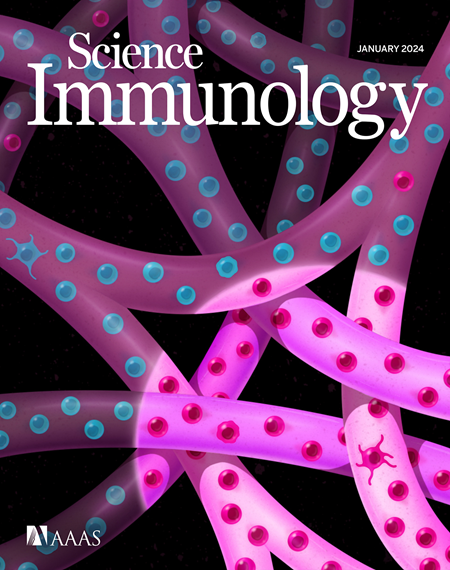Recruited atypical Ly6G+ macrophages license alveolar regeneration after lung injury
IF 17.6
1区 医学
Q1 IMMUNOLOGY
引用次数: 0
Abstract
The lung is constantly exposed to airborne pathogens and particles that can cause alveolar damage. Hence, appropriate repair responses are essential for gas exchange and life. Here, we deciphered the spatiotemporal trajectory and function of an atypical population of macrophages after lung injury. Post–influenza A virus (IAV) infection, short-lived monocyte-derived Ly6G-expressing macrophages (Ly6G+ Macs) were recruited to the alveoli of lung perilesional areas. Ly6G+ Macs engulfed immune cells, exhibited a high metabolic potential, and clustered with alveolar type 2 epithelial cells (AT2s) in zones of active epithelial regeneration. Ly6G+ Macs were partially dependent on granulocyte-macrophage colony-stimulating factor and interleukin-4 receptor signaling and were essential for AT2-dependent alveolar regeneration. Similar macrophages were recruited in other models of injury and in the airspaces of lungs from patients with suspected pneumonia. This study identifies perilesional alveolar Ly6G+ Macs as a spatially restricted, short-lived macrophage subset promoting epithelial regeneration postinjury, thus representing an attractive therapeutic target for treating lung damage.
肺损伤后招募的非典型 Ly6G+ 巨噬细胞许可肺泡再生
肺部经常暴露于空气中的病原体和微粒,这些病原体和微粒会造成肺泡损伤。因此,适当的修复反应对气体交换和生命至关重要。在这里,我们破译了肺损伤后非典型巨噬细胞群的时空轨迹和功能。甲型流感病毒(IAV)感染后,短寿命的单核细胞衍生的表达 Ly6G 的巨噬细胞(Ly6G+ Macs)被招募到肺周区域的肺泡中。Ly6G+ Macs吞噬免疫细胞,表现出很高的新陈代谢潜能,并与肺泡2型上皮细胞(AT2s)聚集在上皮再生活跃的区域。Ly6G+ Macs部分依赖粒细胞-巨噬细胞集落刺激因子和白细胞介素-4受体信号,是AT2依赖性肺泡再生的关键。在其他损伤模型和疑似肺炎患者的肺间隙中也招募到了类似的巨噬细胞。这项研究发现肺泡周围的 Ly6G+ Macs 是一种空间受限、寿命短的巨噬细胞亚群,可促进损伤后的上皮再生,因此是治疗肺损伤的一个有吸引力的治疗靶点。
本文章由计算机程序翻译,如有差异,请以英文原文为准。
求助全文
约1分钟内获得全文
求助全文
来源期刊

Science Immunology
Immunology and Microbiology-Immunology
CiteScore
32.90
自引率
2.00%
发文量
183
期刊介绍:
Science Immunology is a peer-reviewed journal that publishes original research articles in the field of immunology. The journal encourages the submission of research findings from all areas of immunology, including studies on innate and adaptive immunity, immune cell development and differentiation, immunogenomics, systems immunology, structural immunology, antigen presentation, immunometabolism, and mucosal immunology. Additionally, the journal covers research on immune contributions to health and disease, such as host defense, inflammation, cancer immunology, autoimmunity, allergy, transplantation, and immunodeficiency. Science Immunology maintains the same high-quality standard as other journals in the Science family and aims to facilitate understanding of the immune system by showcasing innovative advances in immunology research from all organisms and model systems, including humans.
 求助内容:
求助内容: 应助结果提醒方式:
应助结果提醒方式:


